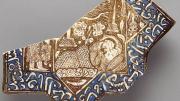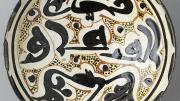In the catalog of the exhibition of Islamic art from the Calderwood collection, at the Harvard Art Museums through May, Mary McWilliams writes, “No obvious factor emerges to suggest what might have motivated a middle-aged woman living in suburban Boston to immerse herself in an artistic tradition that was neither easily mastered nor at the time broadly popular.” McWilliams is the Norma Jean Calderwood curator of Islamic and later Indian art, and the middle-aged woman she refers to is Calderwood herself.
Norma Jean and her husband, Stanford, were transplants from their native Colorado. She completed work for her bachelor’s degree at Boston University in her forties and went on to graduate studies in education and Islamic art at Harvard in the 1960s and thereafter. She began to assemble her collection of Islamic art in 1968 and kept at it for three decades. She did indeed master her field and taught at the Museum of Fine Arts, Boston, and at Boston College.
The Calderwoods showered their adopted region with philanthropic benefactions, especially in the arts. They gave her collection to Harvard in 2002; some 150 objects from it comprise the current exhibition, In Harmony. The works include Persian ceramics, illustrated manuscripts of epics such as the medieval Shahnama, drawings, and lacquerware. The museum provides magnifying glasses to help visitors appreciate the minutely detailed manuscripts.
The tenth-century earthenware bowl at left is from Nishapur in Iran. “Although painted with apparent dash,” McWilliams notes, “the colorful decoration of this bowl is carefully composed. The design is laid out in three registers: an Arabic word meaning ‘harmony’ (al-wif¯aq) occupies the middle, and above and below it are long-necked birds with outstretched wings….Combining Arabic script with birds became popular among potters in the early Islamic era. On this bowl, where inscription and birds are equally stylized and animated, the decorative formula has proved especially felicitous.”
The fragmentary fritware star-shaped wall tile above is also from Iran, from the thirteenth to fourteenth century. It is inscribed in Persian, “...wings were broken....from the prince, felicity came to me. Even if your fate is not auspicious, give in to your destiny.” The artist has expressed the harmony of these lovers by uniting their serene faces within a single nimbus.











